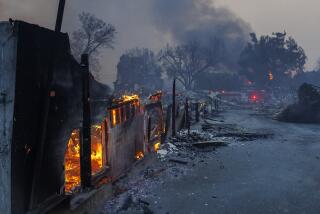LACMA’s most reliable patrons: 10 million taxpayers
- Share via
As the Los Angeles County Museum of Art celebrates its 50th anniversary, it’s worth remembering that its biggest, most steadfast benefactors, past, present and future, are the county’s 10 million residents.
Yes, when it comes to shouldering the financial load for LACMA, celebrated arts philanthropists such as Eli and Edythe Broad, Lynda and Stewart Resnick and Wallis Annenberg have done praiseworthy service. But they all rank far below You, the People.
High-profile benefactors have earned kudos by giving tens of millions each to the museum during the 21st century. The Los Angeles public, through the county government it feeds with taxes and fees, has given $349 million — not counting a $125-million commitment for future construction.
This level of local government funding and the long-term guarantee behind it may be unique in the United States.
The county’s $30-million appropriation for LACMA this fiscal year exceeds New York City’s $26-million commitment to the Metropolitan Museum of Art. And unlike L.A. County, New York City does not lock in funding for the Met and many other cultural institutions that receive government funding. The amounts “can fluctuate depending on the city’s budget,” said Ryan Max, spokesman for New York City’s Department of Cultural Affairs.
“LACMA wouldn’t be where it is without it,” Michael Govan, who has set an ambitious course since becoming the museum’s director in 2006, said of the guaranteed government funding. “It is unique, and I think it’s exciting because it’s given Los Angeles a chance to be competitive.”
Los Angeles County’s commitment accounts for about a third of LACMA’s current annual spending of about $90 million. It can be reduced only if there’s a dire fiscal emergency that forces the county to lay off 2% or more of its full-time employees. Otherwise, LACMA gets annual raises equivalent to the rate of inflation, up to a ceiling of 5%.
Mundane things
Part of the beauty of the arrangement for LACMA is that the county government’s share pays for mundane things that are vital to its operations but have no sex appeal for wealthy private donors looking for public recognition. Mopping the floors, paying the utility bills, stationing guards in galleries — the taxpayers have that covered.
This frees Govan and other LACMA fund-raisers to dangle more glamorous philanthropic opportunities in front of prospective individual and corporate donors, including pursuing the big sums needed for the planned new building by Swiss architect Peter Zumthor.
Whether any private donor will equal or exceed the $125-million bar the county has set with its contribution to the Zumthor plan remains to be seen. Even if they do, Govan says, it won’t buy the right to rename the institution.
“I can’t imagine that, because the county is such a substantial supporter and we’re very proud of it,” the museum director said. “We like to be the Los Angeles County Museum of Art.”
Govan says that sometimes potential donors express concern that LACMA’s endowment is small by major museum standards: It stood at $125.5 million as of June 30, according to the museum’s audited financial statement for 2013-14. But LACMA’s government funding gives him a ready answer: Being able to count on a guaranteed $30-million annual payment from the county is like having an additional endowment of $600 million.
Museums that get substantial government help must balance serving their public and staying in the good graces of wealthy art collectors who typically dominate their boards, said Carol Duncan, a museum historian and author of the book “Civilizing Rituals: Inside Public Museums.”
“There’s a built-in contradiction between a lot of these [private] motives, and the fact that the museums have to justify themselves as an institution that’s going to serve the public,” Duncan said. “Some places have that commitment and do it very well. Others kind of play at it and don’t do it very well.”
By LACMA’s count, 375,041 visitors strolled the galleries or attended lectures or concerts for free during 2013-14 — among them 224,492 kids under 18 and accompanying adults. Those freebies nearly equaled the 391,538 paid admissions. An additional 174,476 visits were by museum members who pay $60 or more to join, with unlimited free admission as one perk.
LACMA offers free general admission to county residents during 11 of its 45 weekly operating hours and has 15 days a year when the $15 general charge is waived for everyone. The museum’s total attendance of 1,229,552 included 288,497 whom it has decided to count as visitors for having strolled the grounds and seen outdoor art installations, such as Chris Burden’s popular “Urban Light.”
Govan says the drive for growth that has yielded two new exhibition buildings, an entrance pavilion and underground parking since 2008 — with the Zumthor plan on deck — would have been inconceivable without the backstop of county funding of regular operations.
“What it’s become, especially in the last decade, is a springboard. It’s allowed us to raise money for buildings and improvements to facilities and to buy art,” he said.
Two pivotal moments in L.A. history lie behind that springboard’s existence — the boom era of the early 1960s and the crippling recession of the early 1990s.
In 1960, the Board of Supervisors agreed to pay all of the future museum’s operating and maintenance expenses — and to put its entire staff on the government payroll. In return, LACMA’s private, nonprofit board agreed to pay construction costs and take responsibility for art acquisitions.
That lavish commitment “reflects a moment when there was a sense that the opportunity was at hand to make a major statement about the city,” said Jonathan Spaulding, an expert on California history. “Los Angeles had been derided for many years, known for Hollywood and the supposed shallowness of its culture.” LACMA and the Music Center, which opened in 1964, would signal that “the city was arriving as a major capital with a commitment to the arts.”
It wasn’t strictly altruistic, Spaulding said. “If you look at who the donor base was, there’s a strong percentage of people involved in real estate development and the build out of Southern California, and there was an awareness that the city needed these cultural amenities” if it was to remain a strong magnet for growth.
In that era of Gov. Edmund G. “Pat” Brown and President John F. Kennedy, he said, there was voter support for government attempting big things with hefty price tags.
But that had changed by the late 1970s, when the anti-tax Prop. 13 passed amid a miserable post-Vietnam War economy that suffered from stagnant growth and rampant inflation. By then the county Board of Supervisors was providing only partial funding of operations, and LACMA’s private, nonprofit board of trustees had to raise the difference itself.
Public funding cut
Running a high-quality museum became untenable when the county cut LACMA’s public funding by nearly a third in 1992 and 1993, from $18 million to $13 million.
“Drastic things were happening,” including layoffs and closing an extra day each week, recalled Melody Kanschat, a former LACMA executive. “The trustees decided to read the original agreements from when LACMA was founded and realized they had a good lever to renegotiate our standing with the county.”
The talks were “endless” but not adversarial, recalled Robert Maguire III, who was then LACMA’s board president. “I was very diplomatic, but the point was they had obligations which had not been fully met for years. The supervisors were ultimately real supportive of the deal,” reached early in 1994. It established the 99-year ironclad funding agreement, with a starting appropriation of $14.2 million.
Maguire said the guarantee had an immediate beneficial domino effect. The deal included a $25-million county loan so the museum could buy the vacant May Co. department store next to its campus, along with surrounding acreage. LACMA also bought land for a parking lot across Wilshire Boulevard from the museum.
LACMA’s expansion in the 2000s couldn’t have happened without the former May Co. land, and the acreage on the south side of Wilshire makes possible perhaps the most striking element of Zumthor’s design — spanning the boulevard with a bridge of galleries leading to a museum building on the other side.
The May Co. building is being turned into a major film museum by the Academy of Motion Pictures Arts and Sciences, which has paid LACMA $36.1 million for a long-term lease and is pushing to finish fund-raising for construction and open in 2018. The academy isn’t looking for any county money. Times have changed.
Twitter: @boehmm
More to Read
The biggest entertainment stories
Get our big stories about Hollywood, film, television, music, arts, culture and more right in your inbox as soon as they publish.
You may occasionally receive promotional content from the Los Angeles Times.











